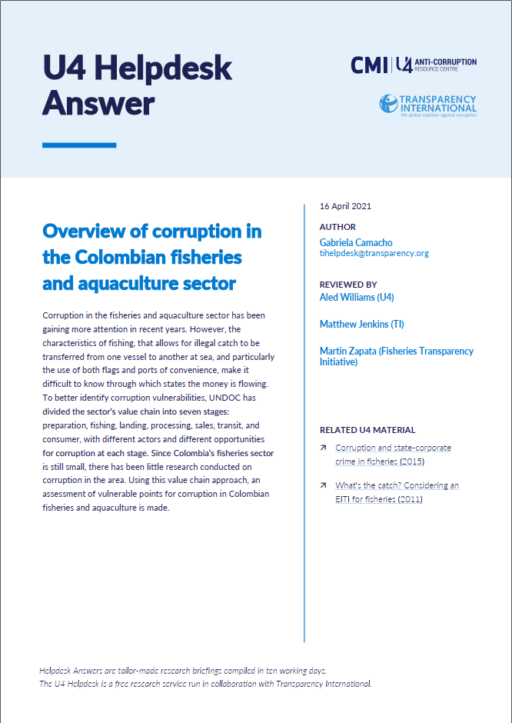- Home
- Anti-Corruption Helpdesk
- Overview of corruption in the Colombian fisheries and aquaculture sector
Overview of corruption in the Colombian fisheries and aquaculture sector

This Anti-Corruption Helpdesk brief was produced in response to a query from a U4 Partner Agency. The U4 Helpdesk is operated by Transparency International in collaboration with the U4 Anti-Corruption Resource Centre based at the Chr. Michelsen Institute.
Query
Please provide a summary of corruption in the Colombian fisheries and aquaculture sector.
Summary
Corruption in the fisheries and aquaculture sector has been gaining more attention in recent years. However, the characteristics of fishing, that allows for illegal catch to be transferred from one vessel to another at sea, and particularly the use of both flags and ports of convenience, make it difficult to know through which states the money is flowing. To better identify corruption vulnerabilities, UNDOC has divided the sector’s value chain into seven stages: preparation, fishing, landing, processing, sales, transit, and consumer, with different actors and different opportunities for corruption at each stage. Since Colombia’s fisheries sector is still small, there has been little research conducted on corruption in the area. Using this value chain approach, an assessment of vulnerable points for corruption in Colombian fisheries and aquaculture is made.
Contents
- Background: corruption in the fisheries sector
- Corruption risks across the fisheries value chain
- Situation in Colombia
- Entry points to advance transparency and reduce corruption
- References
Main points
- The characteristics of fishing, which can happen far away from land, allows for Illegal, Unreported and Unregulated (IUU) fishing to take place unsanctioned. The use of flags and ports of convenience further complicates efforts of law enforcement in the sector.
- UNDOC (2019) has developed a value chain approach to identify corruption vulnerabilities at each of the seven stages of the chain: preparation, fishing, landing, processing, sales, transit, and consumer.
- Artisanal fisheries are mostly affected by petty corruption and disproportionately affects poorer households.
- Although there is little information for corruption in the Colombian fisheries and aquaculture sector, the main risks come from IIU fishing and possible links of the sector with narcotraffic.
Authors
Gabriela Camacho [email protected]
Reviewers:
Aled Williams (U4), Matthew Jenkins (TI), Martin Zapata (Fisheries Transparency Initiative)
Date
18/10/2021
Tags
 Download PDF
Download PDF
